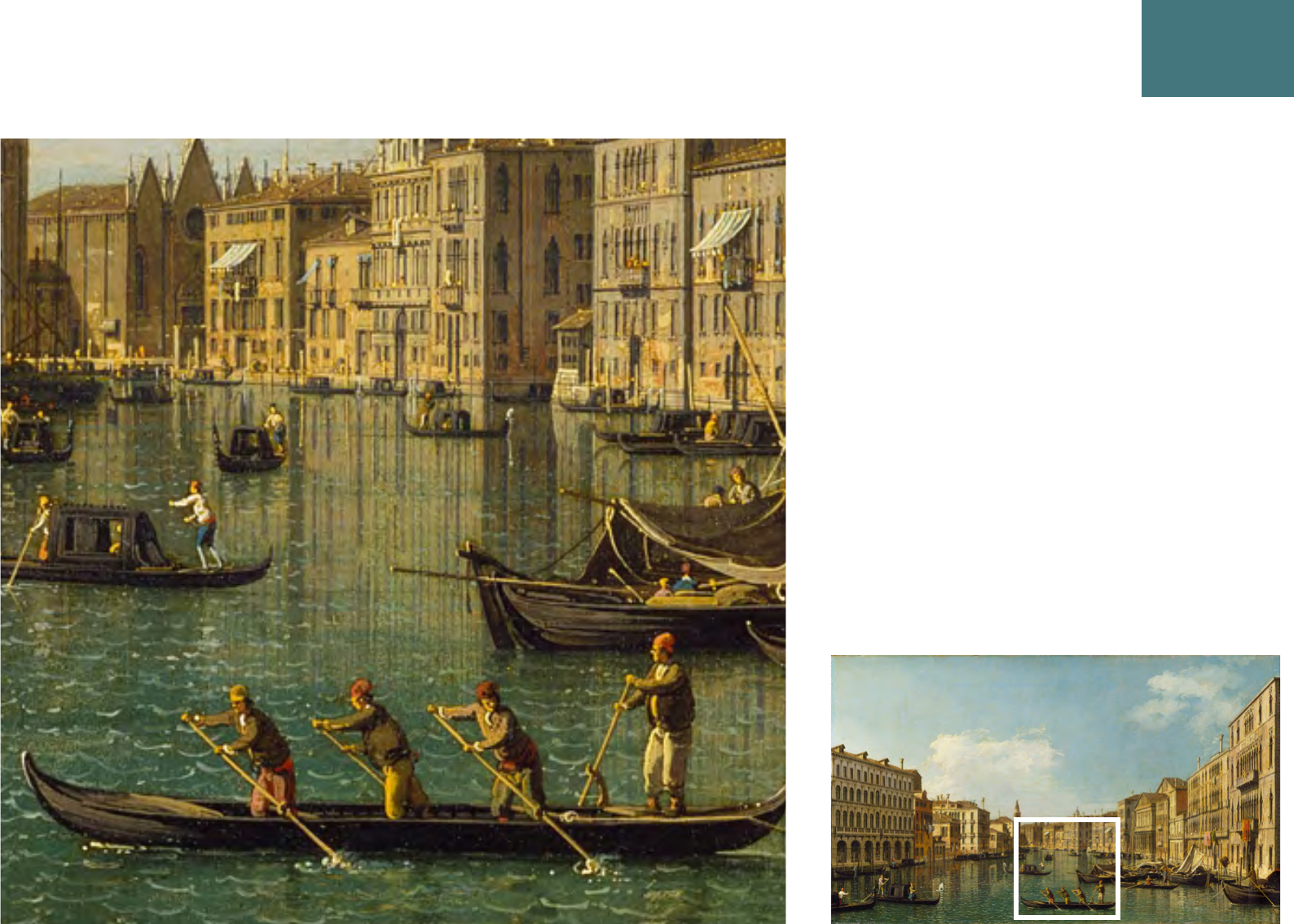
Page 1 of 23
LANDSCAPE
MAKING SPACE
LANDSCAPE
MAKING SPACE
Landscape is the term used to describe paintings of the
outdoors. This subject for paintings and the use of the term
developed in the late 16th century. By the 17th century it became
a recognisable subject for painters and continues to be popular
today. The term landscape conjures up images of nature and the
countryside, giving us a sweeping view of the outside world.
In order to construct the illusion of depth on the flat surface of
the painting (the canvas, wooden panels or paper), artists use
techniques to create the perception of 3D space. This section
will explore this art of perspective.
KEY WORKS
Perspective, linear perspective, aerial perspective, scale
KEY WORDS AND CONCEPTS
Jacob van Ruisdael, Landscape with a
Village, c. 1650–55
Canaletto, Venice: the Grand Canal from the
Palazzo Foscari to the Carità, c. 1740–50
Jan Hackaert, An Avenue in a Wood, 1675

Page 2 of 23
LANDSCAPE
MAKING SPACE
LANDSCAPE WITH A VILLAGE
Landscape with a Village
c. 1650–55
72 x 90 cm
Oil on canvas
Jacob van Ruisdael
1628–1682
The Netherlands
TITLE
DATE
SIZE
MATERIALS
ARTIST
DATES
PLACE

Page 3 of 23
LANDSCAPE
MAKING SPACE
This sweeping open view includes a
welcoming path in the foreground which
leads your eyes (and feet) to the centre and
focal point of the composition: a castle and
its surrounding village. It is probably a view
of Steinfurt Castle in Burgsteinfurt, in the
German region of Westphalia.
While the castle and buildings are central
to the composition, and would have been
recognised as a symbol of strength and
steadfastness, nearly two thirds of the canvas
is filled with sky and billowing clouds. A pair
of figures – one in red to attract our attention
and pointing towards the view to draw us into
the focus of the picture – are dwarfed by the
vastness of the landscape.
THE PAINTING
Trained by his father and uncle who were also
artists, Jacob van Ruisdael became specialised
in and renowned for painting the outdoors.
Landscapes were relatively new subjects for
painters and flourished in the new Dutch
Republic at a time when the church was no
longer commissioning paintings for worship
and the growing number of wealthy merchants
favoured pictures of more everyday subjects
such as portraits, still lifes and landscapes.
It is thought the artist visited this location
when travelling in 1650. On his travels, van
Ruisdael would have made numerous sketches
of views and landmarks which he incorporated
into later paintings. Van Ruisdael’s drawing of
this same view can be found here:
https://www.metmuseum.org/art/collection/
search/337493
THE ARTIST
This landscape, like many others, achieves
the illusion of depth by systematically using
colder colours to depict land which is further
away. Note that the very last hill on the
horizon is painted a bright shade of blue. As
you move into the foreground, the colours
used go from blue, to green, to yellow, and
finally to brown – from cold colours to warm
colours.
This effect had first been observed and
recorded by Leonardo da Vinci in the 15th
century, who theorised that artists should
use this strategy of aerial perspective to help
create paintings of realistic and extensive
landscapes.
AERIAL PERSPECTIVE
LANDSCAPE WITH A VILLAGE

Page 4 of 23
LANDSCAPE
MAKING SPACE
• Where are we? Indoors, outdoors? How do we tell?
• Is it a wild place? Or one where there are people? Where might it be?
• What time of day might it be? How can you tell?
• What is the weather like? What season is this?
• Would you be able to hear or smell anything in this landscape?
• Where would you like go in this landscape? Where would you sit for a rest?
• Does anyone live in this landscape? How can you tell? Is anyone outside?
• What is this land used for? Is anyone working in this landscape?
• Why would you go out in this landscape? Where might you be going?
• How do you get to the village?
• What would you be wearing to be out in this landscape?
DISCUSS
• Arrange colours from cold to warm
to make a collage landscape (see
animation on page 9).
• Make a black and white photocopy
of this painting and turn it into a
different season by colouring it in
using different colours.
• What can be made from all
the materials available in the
landscape? Imagine a marketplace;
what would everyone be selling?
ACTIVITIES
LANDSCAPE WITH A VILLAGE
?
?

Page 5 of 23
LANDSCAPE
MAKING SPACE
IN DETAIL
LANDSCAPE WITH A VILLAGE

Page 6 of 23
LANDSCAPE
MAKING SPACE
LANDSCAPE WITH A VILLAGE
IN DETAIL

Page 7 of 23
LANDSCAPE
MAKING SPACE
LANDSCAPE WITH A VILLAGE
IN DETAIL

Page 8 of 23
LANDSCAPE
MAKING SPACE
LANDSCAPE WITH A VILLAGE
IN DETAIL

Page 10 of 23
LANDSCAPE
MAKING SPACE
An Avenue in a Wood
c. 1675
60 x 50 cm
Oil on canvas
Jan Hackaert
1628–1685
The Netherlands
TITLE
DATE
SIZE
MATERIALS
ARTIST
DATES
PLACE
AN AVENUE IN A WOOD

Page 11 of 23
LANDSCAPE
MAKING SPACE
This landscape invites you to journey through
it by placing the open road right in the
foreground of the picture, and by making the
winding road the central subject of the image.
A sense of atmosphere is created by the
light, which casts strong golden colours and
shadows across the composition.
THE PAINTING
Like Jacob van Ruisdael, Jan Hackaert was one
of a growing number of painters in the so-
called Dutch Golden Age of the 17th century
who specialised in depicting landscapes.
Specialising as a landscape painter, he would
often collaborate with other artists. In this
example, Hackaert painted the landscape but
another painter may be responsible for the
figures.
THE ARTIST
AN AVENUE IN A WOOD
DIMINISHING SCALE
The extent and distance of the road is
described by using the perspective device of
diminishing scale: the trees that line the road
are systematically reduced in size to give the
impression of depth.

Page 12 of 23
LANDSCAPE
MAKING SPACE
• Do you feel you are being welcomed into this painting? How?
• What would you feel like doing in this landscape? Sit down for a picnic or go
for a walk?
• Where does the road lead? Can you see a destination, or are people just
passing through?
• How would you have travelled along this road in the past? How would you
travel along it today?
• Where might the people in the painting be going? What might they be doing?
• What are the dogs doing?
• Where is the furthest point along the road?
• Do you think the trees at the back are shorter in real life or just in the
painting?
• Why has the artist painted the trees that are far away so much smaller?
DISCUSS
• Use a ruler to measure the trunks
of the trees to show how much
taller or shorter the trees are at the
front and back of the painting.
• Line children up along the
playground and take a picture of
them; notice how those further
away appear smaller even if they
are not shorter than their peers.
• Use gridded paper to draw a shape
and then repeat that shape on a
smaller and bigger scale (see page
16).
ACTIVITIES
?
?
AN AVENUE IN A WOOD

Page 13 of 23
LANDSCAPE
MAKING SPACE
AN AVENUE IN A WOOD
IN DETAIL

Page 14 of 23
LANDSCAPE
MAKING SPACE
AN AVENUE IN A WOOD
IN DETAIL

Page 15 of 23
LANDSCAPE
MAKING SPACE
AN AVENUE IN A WOOD
IN DETAIL

Page 16 of 23
LANDSCAPE
MAKING SPACE
Increasing scale using a gridACTIVITY
AN AVENUE IN A WOOD

Page 17 of 23
LANDSCAPE
MAKING SPACE
Venice: the Grand Canal from the Palazzo Foscari to the Carità
c. 1740–50
44 x 77 cm
Oil on canvas
Canaletto (Giovanni Antonio Canal)
1697–1768
Venice, Italy
TITLE
DATE
SIZE
MATERIALS
ARTIST
DATES
PLACE
VENICE: THE GRAND CANAL

Page 18 of 23
LANDSCAPE
MAKING SPACE
This is a sweeping and seemingly accurate
representation of the Grand Canal in Venice.
Painted in the 18th century when Venice was
a popular tourist destination for European
travellers, it depicts the motifs most associated
with the city: the sunlight reflected on the
waters of the canal, the chimney pots against
the skyline, the gondolas carrying visitors and
the city’s churches and bell towers.
THE PAINTING
Like so many artists before him, Canaletto was
trained by his father, a successful painter of
theatrical scenery. Known professionally by
his nickname ‘little canal’, Giovanni Antonio
Canal (1697–1768) is best remembered as a
painter of his home city of Venice, which he
depicted with detail and precision.
These views of the famed city were very much
prized by wealthy gentleman tourists who
visited Venice from England on their ’grand
tour’ – the equivalent of a gap year for the noble
and wealthy of the 18th century. As a result,
the majority of Canaletto’s work is in British
collections today and the Wallace Collection
has many examples.
THE ARTIST
This landscape, or more specifically cityscape,
is constructed using linear perspective. This
system was used and theorised by artists from
the Renaissance onwards to create the illusion
of 3D space.
Linear perspective uses a fictitious ‘vanishing
point’, placed along the line of the horizon
(here in the centre of the composition) at
which all parallel lines or ‘orthogonals’ in the
composition converge or meet.
LINEAR PERSPECTIVE
VENICE: THE GRAND CANAL

Page 19 of 23
LANDSCAPE
MAKING SPACE
• Where are we? Do you know what this city is called?
• Is this a landscape? Or a cityscape?
• Do you think this is a real place or imaginary?
• What helps us recognise a famous city? What is a landmark?
• How do people get around in this city? What are these boats called?
• What makes this city unusual?
• What are the advantages and disadvantages of a city on water?
• Is it busy? What are people doing?
DISCUSS
• Use Google Street View to have
a look at this view of the city of
Venice today.
• Research how global warming and
the rising water levels are affecting
the city.
• Research other places where
people live over water.
• Make a simple one-point
perspective drawing (see page 23).
ACTIVITIES
?
?
VENICE: THE GRAND CANAL

Page 20 of 23
LANDSCAPE
MAKING SPACE
VENICE: THE GRAND CANAL
IN DETAIL

Page 21 of 23
LANDSCAPE
MAKING SPACE
VENICE: THE GRAND CANAL
IN DETAIL

Page 22 of 23
LANDSCAPE
MAKING SPACE
VENICE: THE GRAND CANAL
IN DETAIL

Page 23 of 23
LANDSCAPE
MAKING SPACE
How to draw a simple one-point linear perspective
ACTIVITY
VENICE: THE GRAND CANAL
Vanishing point Horizon
Orthogonals
Orthogonals

